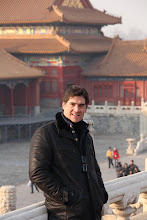The Bund is a famous waterfront and regarded
as the symbol of Shanghai for hundreds of years. It is on the west bank of Huangpu River from the Waibaidu Bridge to
Nanpu Bridge and winds 1500 meters (0.93 mile) in length. The most famous and
attractive sight which is at the west side of the Bund are the 26 various
buildings of different architectural styles including Gothic, Baroque,
Romanesque, Classicism and the Renaissance. The 1,700-meters (1,859 yards) long
flood-control wall, known as 'the lovers' wall', located on the side of Huangpu
River from Huangpu Park to Xinkai River and once was the most romantic corner
in Shanghai in the last century. After renovation, the monotone concrete
buildings that lovers leaned against in the past have been improved into
hollowed-out railings full of romantic atmosphere. Standing by the railings,
visitors can have a 'snap-shot' view of the scenery of Pudong Area and Huangpu
River.
History
Before the 1840s, the Bund was a muddy narrow lane with tall reeds. It
initially became a British settlement. After Shanghai was established as the
trading port in 1846, a street was paved there and the riversides were
reinforced. Then, rows of commercial buildings were constructed. As the UK
Concession, a building boom at the end of 19th century and beginning of 20th
century led to the Bund becoming a major financial hub of East Asia. It was the
centre of the city's politics, economy and culture more than a hundred years
ago, consulates of most countries and many banks, businesses and newspaper
offices were settled there, and that's why we have these art-like buildings.
In the late 1970s and early 1980s, with the thawing of economic policy
in the People's Republic of China, buildings on the Bund were gradually
returned to their former uses. Government institutions were moved out in favor
of financial institutions, while hotels resumed trading as such.
In the 1990s the Shanghai government attempted to promote an extended
concept of the Bund to boost tourism and land values in nearby areas. From
2008, a major reconfiguration of traffic flow along the Bund was carried out. After
a 33-month upgrade, the Bund was reopened to visitors on March 28, 2010. The
veil on the new Bund was finally lifted.
After the reconstruction, most transit
vehicles which originally got through the ground level roads began to make
their way through the new underground tunnel. The original eleven driveways on
the Bund ground were compressed into four two-way lanes. Thus more space was
left for expending the four major squares: Huangpu Park, Chen Yi Square, the
Bund Financial Square, and the Observatory Plaza. After being reconstructed,
the new Bund waterfront is neat and atmospheric. The public activity space is
expansive embracing more visitors.

No comments:
Post a Comment